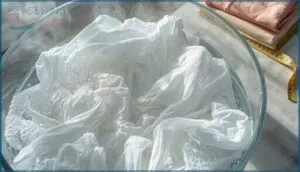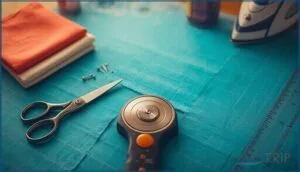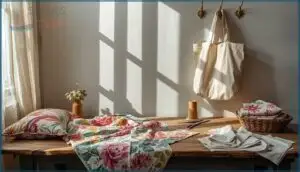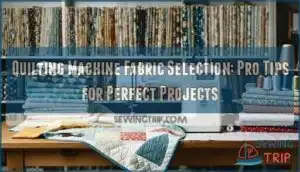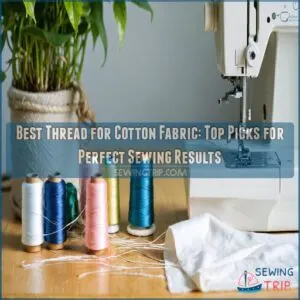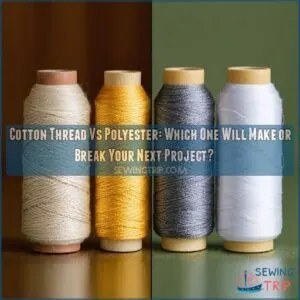This site is supported by our readers. We may earn a commission, at no cost to you, if you purchase through links.
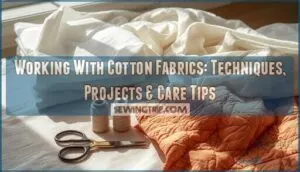
Cotton fabric feels different under your fingers depending on what you’re holding. That tight, crisp poplin behaves nothing like the soft drape of muslin, and understanding these differences changes everything about your sewing results.
Working with cotton fabrics requires more than just threading your machine and hoping for the best. The weight, weave, and finish of your cotton determine whether your dress shirt looks professionally fitted or homemade, whether your quilt lies flat or puckers at the seams.
Learning to prep, cut, and stitch cotton properly means fewer frustrating do-overs and more projects you’re proud to show off or give away.
Table Of Contents
Key Takeaways
- Pre-washing cotton fabric before cutting prevents 4-7% shrinkage and removes factory finishes that interfere with stitching, making it essential preparation for professional results.
- Matching fabric weight to project type transforms success rates—lightweight cotton (100-170 GSM) flows in dresses while heavyweight options (over 340 GSM) provide structure for jackets and upholstery.
- French seams hide raw edges beautifully in lightweight cottons like voile, while straight seams with proper finishing deliver durability for everyday cotton items at different weights.
- Storing cotton in climate-controlled environments at 65-70°F with 30-50% humidity using acid-free tissue prevents mold and fiber breakdown that shortens the lifespan of finished projects.
Choosing The Right Cotton Fabric
Cotton comes in more varieties than you might expect, and each type has a different purpose. Understanding the differences between weaves, weights, and finishes helps you match the right fabric to your project.
Let’s look at the main cotton types you’ll encounter and how to choose based on what you’re making.
Poplin, Muslin, and Broadcloth
Cotton fabric comes in distinct plain-weave varieties, each with unique characteristics. Poplin features a tight weave and crisp texture, making it ideal for dress shirts and formal wear. Muslin offers an economical, soft option perfect for mockups and linings.
Broadcloth, often blended with polyester at 65/35 ratios, delivers wrinkle resistance and durability for everyday sewing applications. This blend is popular because of its enhanced durability and strength.
Quilting Cotton Vs. Apparel Cotton
You’ll find two primary cotton categories at the fabric store, each engineered for specific projects. Quilting cotton features a tight plain weave with approximately 70 threads per inch, delivering structure and durability for piecing work. Apparel cotton, by contrast, prioritizes drape and softness through finer yarns and lower thread counts.
Here’s how they differ:
- Structure: Quilting cotton’s 140-160 gsm weight creates firmness, while apparel cotton flows easily for garments
- Width: Quilting cotton usually measures 44-45 inches; apparel cotton spans 55-60 inches
- Shrinkage: Expect 3-5% shrinkage in quilting cotton versus 2-4% in apparel varieties
Understanding the quilting cotton basics is essential for selecting the right fabric.
Specialty Cottons (Flannel, Eyelet, Denim)
Beyond the basics lie specialty weaves that expand your creative toolkit. Cotton flannel’s brushed surface traps heat effectively, perfect for winter pajamas and cozy bedding. Eyelet fabric features delicate cutouts that boost breathability in summer dresses.
Denim production has evolved dramatically—this cotton twill now reaches $14 billion in global market value, with eco-friendly processes improving both durability and sustainability.
Each specialty cotton brings distinct texture and function to your projects.
Selecting Cotton by Weight and Drape
Understanding fabric weight and drape transforms your sewing decisions. Cotton fabric weight, measured in GSM (grams per square meter), directly impacts your project’s success—lightweight cotton (100-170 GSM) flows beautifully in summer dresses, while heavyweight options (over 340 GSM) bring structure to jackets and upholstery.
Cotton drape analysis reveals that lighter weights create soft, flowing silhouettes, while heavier fabrics hold their shape. Your GSM measurement tips help match fabric to function—consider both weight and weave when planning projects.
Your fabric weight guide starts here:
- Summer shirts: Choose 120-160 GSM for breathable fabrics that keep you cool
- Everyday wear: Select 160-190 GSM for durable fabrics with reliable structure
- Winter garments: Opt for 200-300 GSM weighted fabric choices that provide warmth
- Quilting projects: Work with 133-160 GSM for stable stitching with moderate flexibility
- Structured pieces: Use midweight cotton (170-340 GSM) when drape style selection requires body and shape
Preparing Cotton Fabric for Sewing
Before you make your first cut, you need to prepare your cotton fabric properly. This step can make or break your finished project, and it’s where many sewers run into avoidable problems.
Let’s walk through the essential preparation techniques that’ll set you up for success.
Pre-washing and Shrinkage Prevention
Think of pre-washing as your insurance policy against disappointing shrinkage—pure cotton fabrics usually contract 4% to 7% during their first wash. You’ll want to launder your cotton fabric using the same method you plan for the finished garment: cold or warm water on a gentle cycle works best.
Pre-washing cotton is insurance against shrinkage—pure cotton contracts 4% to 7% on first wash
This prewashing step removes manufacturing residues while allowing fibers to relax naturally before you cut your pattern pieces.
Removing Factory Finishes
Once you’ve completed prewashing, your fabric preparation has tackled two challenges at once. Laundering both preshrinks cotton but also strips away factory finishes applied during weaving—those sizing agents and surface treatments that can interfere with your stitching.
Here’s what happens during fabric preparation:
- Chemical desizing breaks down starch-based coatings using natural enzymes
- Scouring cotton removes oils and waxes with gentle alkaline solutions
- Enzymatic treatments soften fibers while reducing surface pilling
- Mercerization process enhances dye absorption and fabric luster
Mechanical methods like singeing smooth protruding fibers, though this occurs at the mill level before you purchase your yardage.
Drying and Pressing Techniques
After washing, you’ll need to master drying and pressing techniques that protect your cotton fabric. Air drying remains the gentlest option—hang damp pieces in a shaded spot to prevent fading, then reshape them to minimize wrinkles. For machine drying, use low heat settings and remove items promptly to avoid shrinkage. When pressing, cotton tolerates high temperatures around 400°F, but always let the fabric cool completely.
| Method | Best Practice |
|---|---|
| Air drying | Shake out excess water; hang in ventilated shade |
| Heat settings | Use low or air-fluff; avoid high temperatures |
| Iron pressure | Apply medium to high pressure with steam iron |
| Wrinkle management | Remove from dryer promptly; iron while slightly damp |
Cutting Tips for Cotton Fabrics
Sharp fabric cutting tools make all the difference in sewing accuracy. Rotary cutters speed up cotton preparation by 40% on flat surfaces, while scissors excel at precise pattern work.
Before cutting, press your fabric and apply starch to stabilize the weave—this delivers sharper edges and reduces fraying by 33% when you cut along the grainline.
Layer management matters: stick to two layers for intricate shapes to maintain edge finishing quality.
Essential Sewing Techniques for Cotton
Now that your cotton fabric is prepped and ready, it’s time to master the core techniques that’ll make your projects look polished and professional. The right seam, stitch, or edge finish can mean the difference between something homemade and something handcrafted.
Let’s walk through the essential methods every cotton sewer should have in their toolkit.
Straight Seams and French Seams
When you’re ready to join fabric pieces together, mastering two fundamental sewing techniques will transform your cotton projects. Here’s what you need to know about seam finishing and fabric selection:
- Straight seams work best for everyday cotton items, offering reliable seam strength with a standard 3/8-inch allowance.
- French seams excel with lightweight cotton fabrics like voile, hiding raw edges beautifully.
- Seam finishes affect cotton durability—choose based on your fabric’s weight and intended use.
- Sewing efficiency varies: straight seams save time, while French seams deliver refined results.
- Consider your project’s wash frequency when selecting between these essential sewing techniques.
Topstitching and Decorative Stitches
Topstitching transforms ordinary cotton seams into polished, professional details. You’ll want heavy-duty thread like Gutermann for clear stitch definition, paired with a 90/14 topstitching needle to prevent breakage. Sew parallel lines in one pass to avoid puckering, and watch your guide rather than the needle for straighter results.
Decorative stitches add texture to home textiles and apparel, increasing perceived value without extra embellishments.
Finishing Edges: Serging and Overlocking
After topstitching creates visible structure, serging techniques secure what’s hidden—those raw edges that fray with wear. Your serger trims and encases fabric edges simultaneously using overlock stitches, preventing unraveling far better than pinking shears.
A four-thread overlock stitch reinforces stress-prone seams in heavier cottons, while three-thread finishes suit lightweight weaves. Think of edge finishing as insurance: invisible seam reinforcement that extends garment lifespan through countless wash cycles.
Needle and Thread Selection for Cotton
Edge finishing protects seams, but needle selection determines whether those seams form correctly. Universal needles sized 80/12 handle most cotton weaves without snagging fibers, while lightweight voiles need 70/10 points.
Pair them with 50-weight mercerized cotton thread—it matches fabric thickness and shrinkage behavior. Your sewing machines’ thread tension stays balanced when needle sizes correspond to thread weight, preventing puckering across different cotton fabrics.
Creative Sewing Projects With Cotton
Cotton’s versatility makes it the perfect starting point for countless sewing projects, whether you’re building a wardrobe or updating your living space.
From everyday garments to practical home goods, cotton fabric lends itself to your creative vision with ease.
Let’s explore some popular projects that showcase what cotton can do in your hands.
Clothing: Shirts, Dresses, Kids’ Wear
When you’re ready to create garments, cotton’s versatility shines through countless options. You can draft button-up shirts using crisp poplin or experiment with cotton voile and cotton lawn for flowing dresses that drape beautifully.
Dressmaking with sustainable fashion principles in mind means understanding cotton sourcing and fabric dyeing impacts.
For kids’ wear, jersey knits offer stretch and comfort, while garment patterns in organic cotton address sensitive skin concerns through thoughtful textile innovations.
Home Decor: Pillowcases, Curtains, Aprons
Beyond garments, cotton textiles transform your living spaces through practical home accents. Pillowcases in seasonal colors—like the trending deep blue “Nocturne”—showcase fabric patterns while offering natural breathability.
Cotton curtains provide thermal insulation and moisture absorption, though you’ll want to avoid direct sunlight to prevent fading.
Kitchen aprons see peak interest during holiday cooking seasons, combining durability with easy washing for your most-used sewing projects.
Accessories: Tote Bags, Bucket Hats
Small-scale accessories let you explore cotton fabric versatility without major time investments. Cotton tote bags—projected to reach USD 1.11 billion by 2025—combine eco-friendly materials with customization potential. Bucket hat designs in cotton-poplin or cotton-twill offer breathable summer accessories, though you’ll need at least 131 uses from your tote to offset environmental impact.
Consider these cotton care tips:
- Pre-wash cotton voile and canvas before cutting
- Select medium-weight cotton for structure
- Finish seams to prevent fraying during use
Quilts and DIY Gifts
Cotton quilting projects connect you to a market projected to reach USD 8.2 billion by 2033. Quilting cotton weighs 4-5 oz per square yard—perfect for durable, breathable creations. Try fat quarter fabric bundles (8-12 coordinated pieces) for gift ideas, or explore DIY kits for quick children’s quilts. Cotton voile and cotton lawn add soft texture variations to your sewing projects.
| Quilt Project Type | Ideal Cotton Weight |
|---|---|
| Baby quilt gifts | 4-5 oz quilting cotton |
| String-pieced bags | Medium cotton voile |
| Fast-sew lap quilts | Pre-treated quilting cotton |
| Custom quilts | Cotton lawn or poplin |
| Scrappy gift projects | Mixed fabric bundles |
Caring for and Storing Cotton Creations
You’ve put time and skill into your cotton creations, so it makes sense to keep them looking their best. Proper care extends the life of your projects, whether they’re garments you wear weekly or quilts you bring out for special occasions.
Let’s walk through the practical steps for washing, storing, and organizing your cotton pieces so they stay fresh and ready to use.
Washing and Drying Best Practices
Your cotton creations deserve care that keeps them looking fresh without shortening their lifespan. Water temperature, detergent use, and drying methods all play vital roles in cotton fabric care and laundering. Sophisticated treatments like mercerization help, but proper washing remains essential.
- Wash cotton garments in cold water to prevent shrinkage and protect fibers
- Choose enzyme-based, mild detergents for effective cleaning without damage
- Air dry when possible, or use low heat machine drying to avoid fiber contraction
- Remove items promptly from the dryer to minimize wrinkles and reduce ironing needs
Preventing Wrinkles and Shrinkage
Two fabric nemeses haunt every cotton sewer: wrinkling and shrinkage. Preparing cotton fabric for sewing starts with controlling these two factors. Preshrinking your fabric before cutting prevents post-wash surprises, while understanding fabric finishing technologies helps you select materials with built-in wrinkle resistance.
Ironing with steam after washing sets fibers properly, while selecting cotton blends or treated fabrics offers enhanced shrinkage control without sacrificing that natural cotton feel you love.
| Prevention Method | Result |
|---|---|
| Pre-wash in hot water | Relaxes fibers, reducing shrinkage to 2-3% |
| Choose tight weaves (poplin, twill) | Minimizes wrinkling and shape distortion |
| Apply wrinkle-resistant cotton treatment | Improves anti-wrinkle performance markedly |
You can dramatically reduce both through strategic preparation and smart finishing choices.
Long-Term Storage Tips
Preserving your finished projects and fabric stash requires thoughtful climate control and archive preservation techniques. Store cotton fabric in a cool, dry environment—ideally 65–70°F with 30–50% humidity—to prevent mold and fiber breakdown.
Use acid-free tissue or breathable muslin wraps rather than plastic for fabric storage. Powder-coated steel cabinets offer excellent pest prevention, while silica gel packets maintain dryness for sustainable fashion practices and lasting fabric care.
Organizing Fabric Pieces for Easy Access
Think of your fabric collection as a working library—easy retrieval starts with smart fabric storage. Group cotton pieces by project type or color, then label bins with clear categories.
Organizing fabric pieces using vertical folding techniques maximizes shelf organization while keeping yardage visible.
For fabric scraps, transparent containers paired with simple labeling systems transform chaos into functional inventory management that saves you time on every project.
Top 3 Cotton Muslin Fabrics for Sewing
Muslin is the workhorse of cotton fabrics—it’s affordable, forgiving, and perfect for both practice pieces and finished projects. Whether you’re drafting a pattern or sewing something simple, the right muslin makes all the difference.
Here are three solid options that cover different weights and uses.
1. Cotton Muslin Fabric Medium Weight Unbleached
When you’re testing patterns or planning your next apparel project, you’ll find this 100% cotton muslin fabric delivers the performance you need. With its 63-inch width and 2-yard cut, this unbleached medium weight fabric brings together natural dyeing methods potential and practical durability.
The smooth finish and soft touch make sewing with cotton fabric straightforward, whether you’re creating toiles or quilting cotton projects. Cotton thread counts in this muslin range from 60×60 to 78×78, providing enough structure for pattern adjustments while maintaining that characteristic drape you expect from quality types of cotton fabric.
2. Hotgoden Lightweight Cotton Muslin Fabric
If lightweight fabrics call your name for summer apparel or delicate quilting projects, you’ll appreciate Hotgoden’s 100% cotton muslin. This breathable fabric spans 63 inches wide with a soft fabric hand that makes sewing machine settings straightforward—no needle adjustments needed.
The natural cotton voile-like drape works beautifully for embroidery backing and baby clothes. Just remember fabric shrinkage prevention: pre-wash in cold water before cutting. Cotton thread selection stays simple with standard all-purpose thread.
Muslin fabric uses extend from beginner practice garments to lightweight summer wear, and cotton muslin care requires only gentle washing to maintain that signature softness.
3. Cotton Muslin Fabric Unbleached Natural Cloth
For natural fiber enthusiasts who value fabric sustainability, unbleached cotton muslin offers a warm off-white canvas perfect for natural dyeing and textile crafts. This breathable medium-weight option—63 inches wide by 2 yards—embraces those natural cotton seed flecks that signal authentic cotton weaving.
Muslin fabric uses span from culinary straining to garment construction, though you’ll want to air it out first to eliminate any initial smell.
The natural, unbleached character makes sewing with cotton fabric feel honest and earthy, ideal for eco-conscious makers exploring sustainable textile practices.
Frequently Asked Questions (FAQs)
How does cotton compare to synthetic fabric blends?
Cotton excels in breathability, absorbency, and sustainability as a natural fiber, but synthetic blends offer enhanced durability and moisture management.
Cost comparison favors blends for longevity, while eco-friendly considerations tip toward cotton’s biodegradable nature.
Can cotton fabric be dyed at home successfully?
Think of transformation like planting seeds—with the right conditions, growth follows.
You can dye cotton fabric at home successfully using fiber-reactive dyes, which bond chemically with natural fibers for excellent color fastness and vibrant results.
What causes cotton fabric to pill over time?
Pilling happens when short fibers work loose through mechanical friction—from wear, washing, or rubbing against other surfaces.
Fabric weave, fiber length, and laundering effects all influence how quickly those fuzzy pills appear on your cotton.
Is organic cotton worth the extra cost difference?
Organic cotton benefits justify the 20-30% premium for eco-conscious sewers. Sustainable fashion choices reduce environmental impact through 91% less water and 98% fewer pesticides.
Cotton farming practices matter when you’re committed to eco-friendly textiles.
How do you fix cotton fabric that shrank?
Sure, toss your ruined shirt in the time machine—or soak it in lukewarm water with hair conditioner for 30 minutes, gently stretch while damp, and air-dry flat. Fiber recovery works best on knits.
Conclusion
Cotton accounts for nearly 25% of all fiber used in textiles worldwide, yet most sewers never tap its full potential. Mastering working with cotton fabrics transforms your projects from acceptable to outstanding.
The prep work, precise techniques, and proper care you’ve learned here aren’t extra steps—they’re the foundation of professional results. Your next cotton creation deserves the confidence these methods provide. Pick up that fabric and start stitching smarter.

